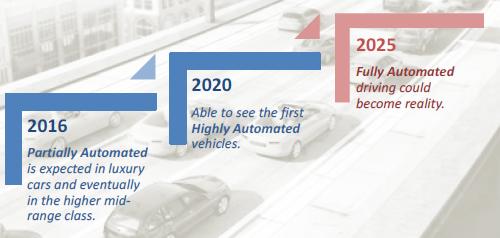We believe we are at the inflection of the take-off of technology-assisted driving. The current penetration of Advanced Driving Assistance System (ADAS) is only 3%. With the recent boom of ADAS and semi-automated auto model introductions, consumer awareness has been heightened.
What is ADAS?
ADAS broadly refers to a set of features which make use of internal software connected to sensors and cameras to alert drivers to potential hazards, or even temporarily take control of the car to avoid dangerous situations. Accomplished through radars, cameras, or laser sensors, these features include adaptive cruise control, parking assist, forward collision warning, predictive emergency braking systems, lane-keeping support, pedestrian and signage recognition, and traffic-jam assist.
ADAS will pave the way for semi-automated driving as various ADAS features working in unison will enable the car to drive itself with minimal human intervention. The end game is the eventual relinquishment of control to the smart car, freeing up the driver for other productive tasks.
 ADAS is on a path to evolve into semi-automated and then automated driving. According to Continental, a leader in auto radar and sensing systems, partially automated cars with sensing features will become a reality in 2016. It expects highly-automated cars to be launched in 2020 and fully-automated driving to be commercially viable in 2025.
ADAS is on a path to evolve into semi-automated and then automated driving. According to Continental, a leader in auto radar and sensing systems, partially automated cars with sensing features will become a reality in 2016. It expects highly-automated cars to be launched in 2020 and fully-automated driving to be commercially viable in 2025.
Perhaps most importantly, ADAS may be the auto industry’s “IPhone” moment—a technology you didn’t know you wanted until you tried it, after which you couldn’t imagine going back. What’s particularly intriguing about this megatrend is that we’re really dealing with two verticals—(a) The ADAS package for safety; and (b) The autonomous driving package for convenience / productivity. As vehicles become connected, drivers may even be able to purchase these apps remotely in what will likely emerge as new business models in automotive. So today’s optional ADAS packages will likely migrate to standard equipment in the coming years thereby allowing automated driving features to slot in as optional equipment. The basic components that will make up the connected cars with ADAS are – Radar, Lidar Sensors and Cameras.
The ADAS market today is relatively small and primarily seen in high-priced vehicle offerings. Most third-party forecasts estimate ADAS market growth at 20-35% annually with forward cameras/radars forecast to outgrow side/360 radars due to regulations.